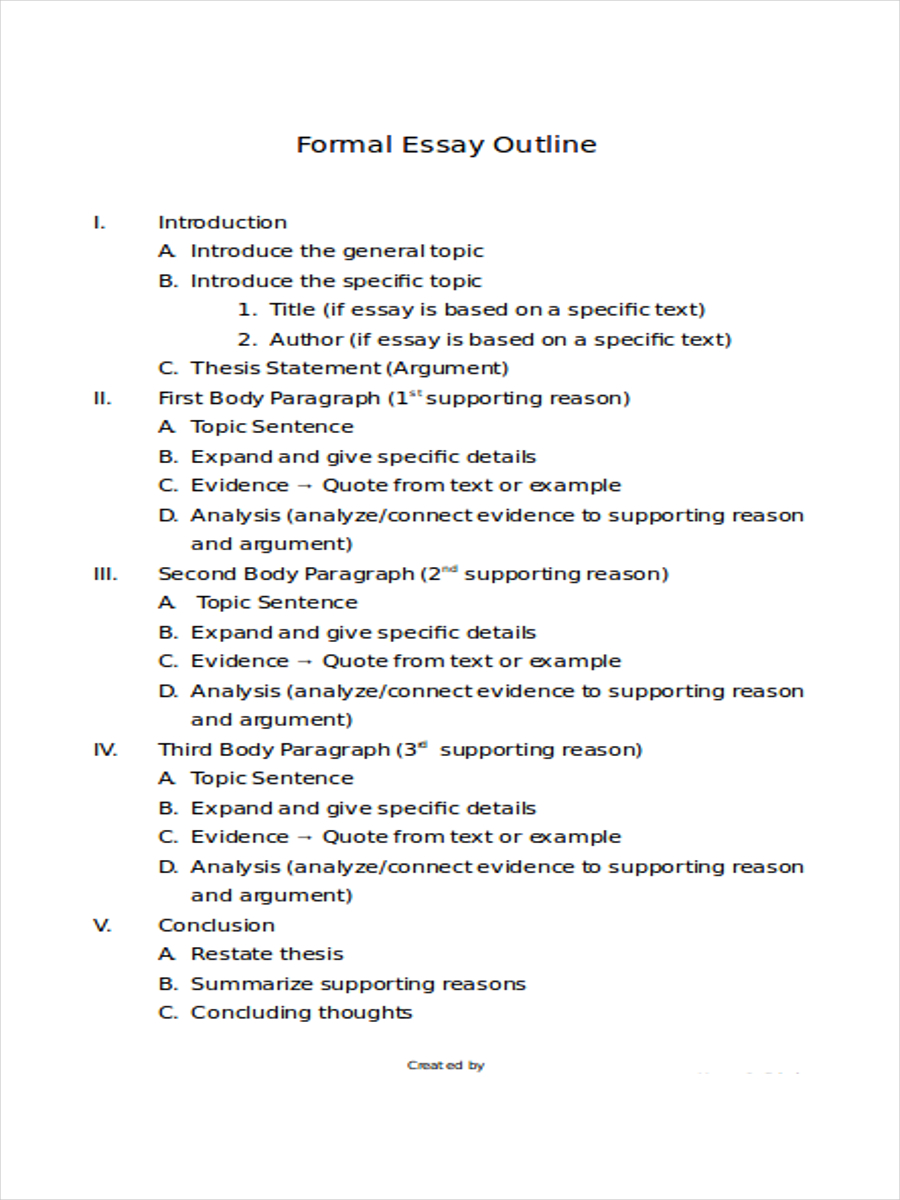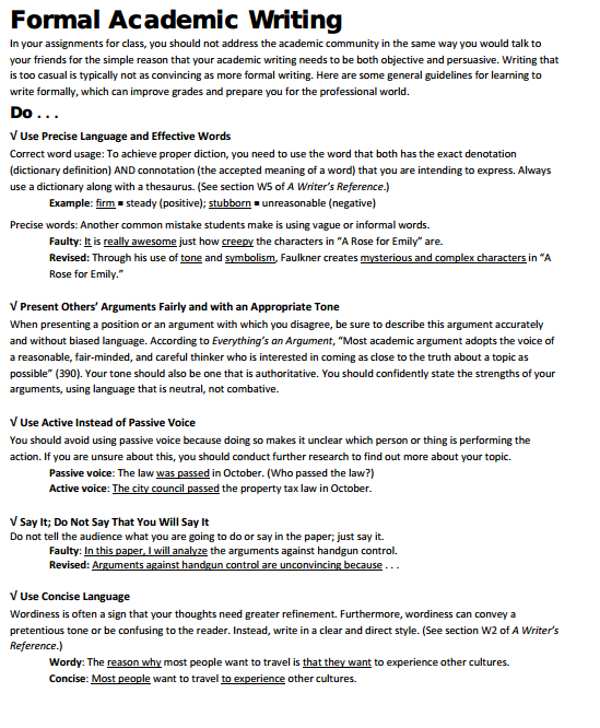
· Writing a formal report is the important, final step of completing a major project. The report needs to follow the Technology Report Guideline of Ontario Association of Certified Engineering Technicians and Technologists (OACETT, ). The purpose of the Technology Report · Essays are similar to a story, pamphlet, thesis, etc. The best thing about Essay is you can use any type of language – formal or informal. It can biography, the autobiography of anyone. Following is a great list of essay topics. We will be adding more soon! But Before that you may wanna read some awesome Essay Writing Tips here. Get the Huge list of + Speech Topics here Basically, a formal essay definition says that the formal essay is an academic level paper that informs the audience of some information. It is opposite to an argumentative essay where you need to choose a controversial topic, take your own position on this topic and prove it using the reasonable and reliable arguments. From my point of view, formal essay writing process is much easier than the argumentative essay`s
Formal Essay: Definition & Examples - Video & Lesson Transcript | blogger.com
Last Updated: November 13, References Approved. This article was co-authored by Jake Adams. With over 14 years of professional tutoring experience, Jake is dedicated to providing his clients the very best online tutoring experience and access to a network of excellent undergraduate and graduate-level tutors from top colleges all over the nation. Jake holds a BS in International Business and Marketing from Pepperdine University. There are 15 references cited in this article, which can be found at the bottom of the page.
wikiHow marks an article as reader-approved once it receives enough positive feedback. In this case, several readers have written to tell us that this article was helpful to them, earning it our reader-approved status. This article has been viewedtimes.
The term "formal essay" formal essay writing makes many people think of high school or college writing classes, but formal essays have many practical uses outside the classroom.
A formal essay may be a requirement in certain job applications and professional reports and correspondences, formal essay writing. Learning how to write a strong formal essay can help you excel in your academic career and your professional career. To write a formal essay, first compose an introductory paragraph that gives background information and includes your thesis statement. Then, write body paragraphs so that each one addresses a point in formal essay writing of that thesis.
For each body paragraph, try to write a clear topic sentence that articulates the point of the paragraph, formal essay writing, and provide supporting evidence for the point and an explanation of how it backs up your thesis. For information from our English Language reviewer on choosing a topic for your formal essay, read on! Did this summary help you? Yes No. Log in Social login does not work in incognito and private browsers.
Please log in with your username or email to continue. wikiHow Account, formal essay writing. No account yet? Create an account. Community Dashboard Write an Article Request a New Article More Ideas Edit this Article.
Courses New Skills for Work New Expert Videos About wikiHow Pro Upgrade Sign In. Home Random Browse Articles Courses New About wikiHow Easy Ways to Help Approve Questions Fix Spelling Quiz App More Things to Try We use cookies to make wikiHow great. By using our site, you agree to our cookie policy. Cookie Settings. wikiHow is where trusted research and expert knowledge come together. Learn why people trust wikiHow. Categories Education and Communications Formal essay writing University and Postgraduate Academic Writing Essays How to Write a Formal Essay.
Download Article Explore this Article parts. Essay Template and Sample Essay. Tips and Warnings. Related Articles, formal essay writing. Article Summary. Co-authored by Jake Adams Last Updated: November 13, References Approved. Essay Template and Sample Essay Essay Template. Support wikiHow and unlock all samples. Part 1, formal essay writing.
Brainstorm possible subjects. Brainstorming is one of the most common methods of topic formation. It allows you to explore multiple possible topics without committing to any of them until you decide what will work best for you.
Set a timer. Choose a time span that will allow you formal essay writing cover a lot of ground, but not formal essay writing large a time span that you find yourself feeling lost and aimless.
Five to ten minutes is generally a good starting point. Try to come up with as many ideas as you can, and jot them down as quickly as possible. You want to have a large list to work with. Look for any patterns or recurring themes in the subjects that you've written down. Choose a topic. Your topic should be a subject that is interesting to you, since you want to be able to write about it at length. If you are writing an essay for school, be sure that your topic fits the assignment you've been given.
If you had multiple items in your brainstorming session that are all related to a central issue or theme, it's a good sign that you will be able to write a lot about that issue.
You may find that your initial topic idea changes considerably as you conduct research and begin writing your essay.
Narrow your topic. Once you've chosen a general subject for your essay, you may need to narrow down the focus of your essay. You don't want a topic so broad that it will take a hundred pages to adequately cover the subject matter, but you also don't want a topic so narrow that the subject will be exhausted in one or two pages.
In this case, formal essay writing, a particular movement in art history would be a good topic to explore in an essay.
Try making an idea map to help you narrow your topic. This entails writing related sub-topics around the central topic you've chosen.
It can be helpful because it allows you to visualize how your topic relates to other concepts. Write a thesis statement. A thesis statement serves as a short preview of what the ensuing essay will address. It should be a claim or opinion that you will work to defend, and it should incorporate or acknowledge any relevant lenses through which you will be analyzing your topic if, for example, you will be applying certain theories to your subject.
If your thesis is simply a statement that anyone else who's done the necessary reading would agree with, you will need to rework your thesis to stake out a stronger opinion. Considering those possible questions can help you develop a claim that you can defend which seeks to answer one of those questions. Part 2. Compose an introduction.
The introductory paragraph should provide readers with sufficient information to know what the essay will be about and what you will seek to prove or disprove in the ensuing text, formal essay writing. Start your introduction with a hook, meaning something that draws your reader in to want to learn more. Insert your thesis statement somewhere near the end of your introductory paragraph.
Write body paragraphs. The formal essay writing paragraphs contain the bulk of an essay. The body should formal essay writing after the introduction and before the conclusion, formal essay writing. The more research that you have done, or the more you have to say about your subject, formal essay writing, the longer the body section will be in your essay. The standard expectation in academic writing is that each paragraph should introduce and explore each "point" that will ultimately prove or disprove your thesis statement.
Compose a topic sentence for each paragraph, and insert that sentence somewhere near the beginning of the paragraph. The topic sentence is usually the first sentence of a body paragraph. A topic sentence should introduce or express the "proof point" of that paragraph, and the ensuing sentences should explain or elaborate on the topic sentence.
Use the so-called "P. Form a conclusion. The final paragraph of a formal essay is called the conclusion. It should not introduce any new information, and should not actually say the words, "in conclusion". The conclusion paragraph may summarize the proof that was laid out in the preceding body paragraphs, or it may offer some larger implication based on the assumption that the thesis has been adequately proven.
How you compose your conclusion will vary, depending formal essay writing the assignment if it's for school or the goal of your essay.
Part 3. Avoid first person writing. Most formal essays avoid using first person pronouns like "I" or "we". This is because the essay seeks to support the thesis statement, and using first person pronouns would render the thesis statement as mere opinion. Think of the thesis statement as an absolute truth that you are supporting, rather than just your own interpretation of a text or event. Use formal vocabulary. A formal essay should not use slang or informal words or phrases.
Pick strong verbs, formal essay writing. Strong verbs are verbs that adequately convey the action of the sentence without requiring a preposition. Verbs that require a preposition are called phrasal verbs, and within the academic community they are typically considered weaker verbs. Write strong transitions. Transitions help weave the various parts of an essay together into a single, cohesive piece of writing. If a transition formal essay writing forced and the sentences before and after the transition are still on the same subject, you most likely do not need a transition.
5 Rules of Formal Academic Writing That Guarantee Better Essay Grades!
, time: 5:25How to Write a Formal Essay

· Writing a formal report is the important, final step of completing a major project. The report needs to follow the Technology Report Guideline of Ontario Association of Certified Engineering Technicians and Technologists (OACETT, ). The purpose of the Technology Report II. WRITING YOUR PAPER (a) Introduction: Provide background information and basic details about your topic. Give direction for your essay and include your thesis statement at the end of your introduction. (b) Body of the paper and paragraphing: Consider the order and sequencing of your arguments · Formal writing tends to include the following: Long and complex sentences: Sentences tend to be compound and contain commas to link two ideas or use transitions like “Furthermore” and “To exemplify,”. Does not use contractions: Would use “cannot” instead of “can’t”. Objective: Does not offer personal opinions/5(65)
No comments:
Post a Comment